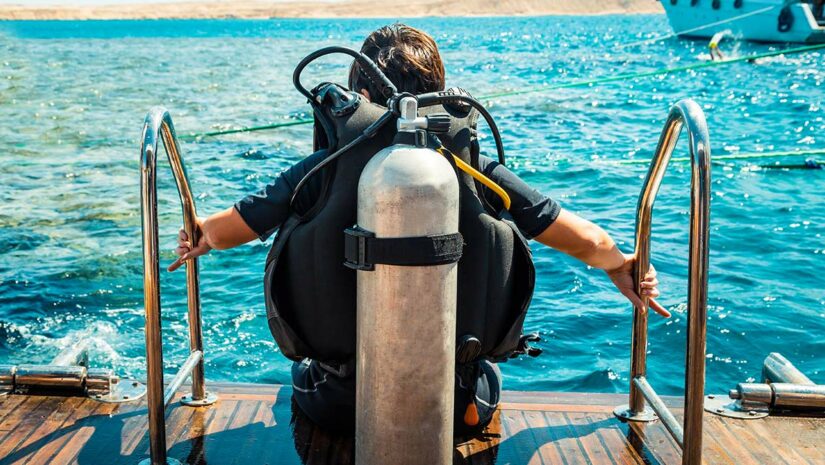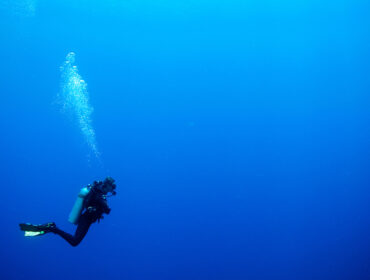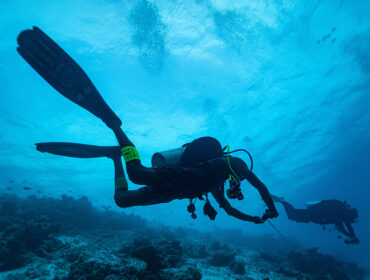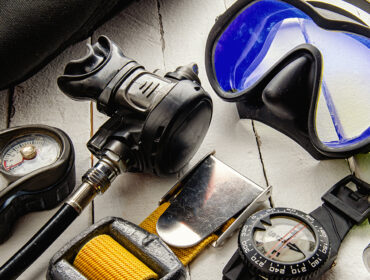Diving into the mysteries of the deep sea is an adventure like no other. But how often do we think about the unsung hero of our diving escapades: the scuba tank? What’s the magic behind these cylindrical objects?
We know the feeling — the lure of the deep blue, the mysteries it holds, and the freedom of being weightless. But beneath that allure, there’s a fundamental need: breathing. And that’s where scuba tanks come into play.
Scuba tanks, often called cylinders or bottles, are high-pressure vessels that store the breathing gas — usually air — for divers. The diving tank is an indispensable component for both seasoned divers and newcomers to scuba. Acting as your underwater lung, it’s what enables you to explore the incredible marine world below the surface. Let’s dive into the details and unravel the mysteries of the scuba diving tank.
History and Evolution of Scuba Tanks
Our dive history began with early explorers using simple air-filled animal bladders to stay submerged. Fast forward to today, and the technological advancements over the years have provided us with the durable, efficient tanks we have today, offering greater depths and longer dive times.
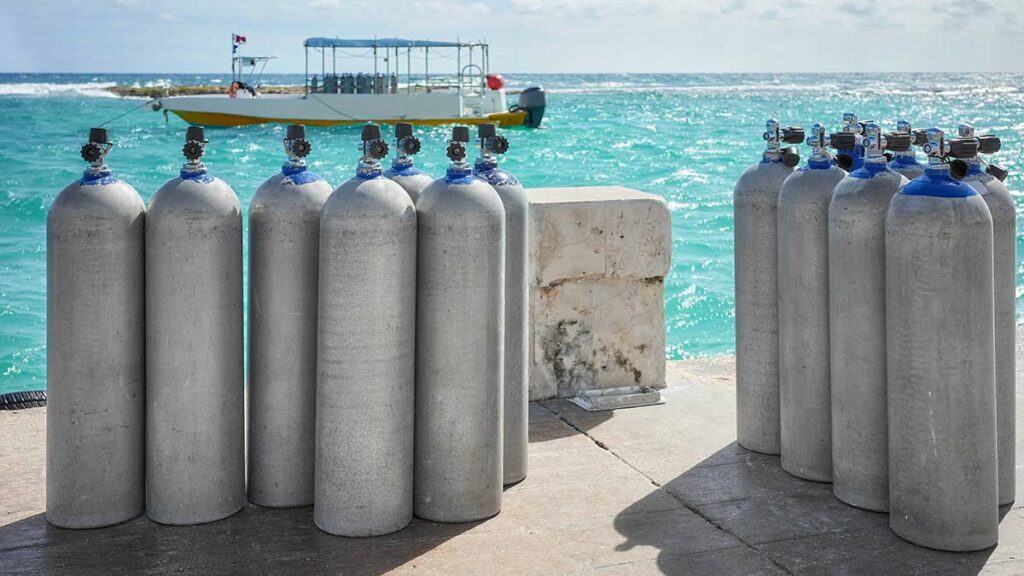
Choosing the Right Scuba Diving Tank
Understanding the differences between tank types will help you choose the right one for your diving needs. There’s no one-size-fits-all here. Dive needs vary, and so do tanks. Scuba tank material is primarily made of either steel or aluminum, and top brands, including Faber, XS Scuba, Catalina, and more,e carry the top tanks on the market.
Aluminum Tanks
Aluminum tanks are more popular with beginners and recreational divers because they are less expensive than steel tanks. Compared to steel, aluminum is resistant to corrosion and rust, thus ensuring longevity. Aluminum-80 is the most common tank used by rental shops.
On the downside, their buoyancy can change as the tank empties. An empty aluminum tank will become positively buoyant, floating as the gas is used. So, the diver will have to wear heavier weights on his belt to compensate for that and to become neutrally buoyant. They can also be prone to dents, as aluminum is softer.
Steel Tanks
Steel cylinders come in various capacities, but some can carry significantly more gas than the enormous aluminum cylinders. They are more durable and resilient and can withstand anything you encounter during your dive. Steel tanks are negatively buoyant, and as you consume air, it becomes neutrally buoyant. This means you will need less weight on your belt than aluminum tanks. They last longer than their aluminum counterparts and are preferred by professional divers.
However, if not correctly cared for, steel is more susceptible to rust, especially in salt water, and its maintenance will always be essential. But with regular care, steel tanks can last for decades. They are also more expensive than aluminum tanks.
It’s like choosing between an apple and an orange — both have merits!
Pony Tanks
Scuba enthusiasts are gravitating more towards the single-tank-and-pony configuration. Think of pony tanks as mini backup air tanks to attach to your diving gear. It’s equipped with its regulators and, occasionally, its gauges. If you ever have an issue with your main gear or use up your air faster than expected, this little buddy ensures you have enough air for a safe and gradual return to the surface. While it’s super handy, remember it’s primarily for emergencies, not to prolong your underwater adventures.
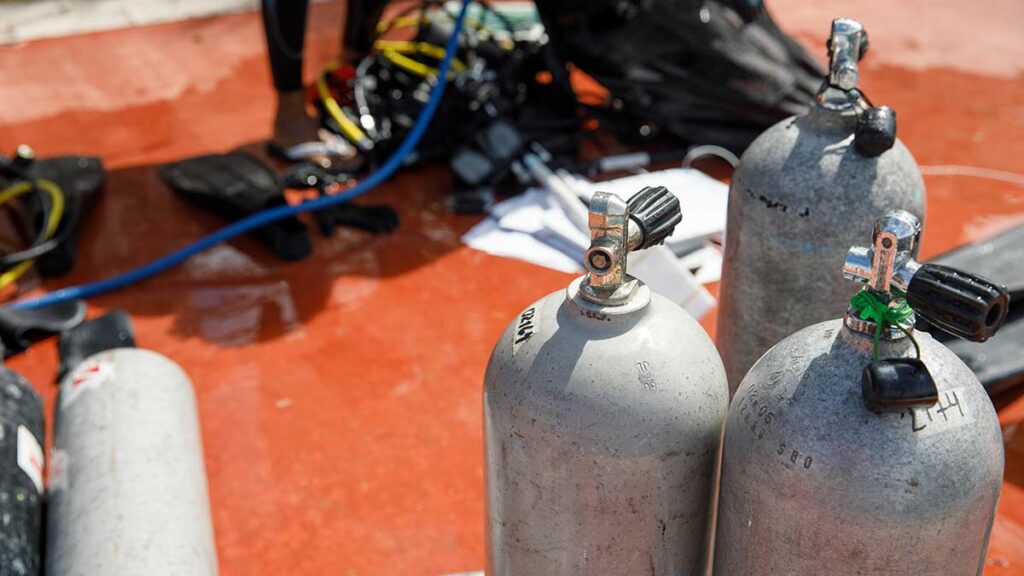
Understanding Scuba Tank Capacity: How Long Can You Stay Under?
The capacity of a tank denotes the amount of gas (in cubic feet) it can contain at its designated pressure. Most recreational tanks range from 50 to 80 cubic feet. Tanks with larger capacities offer more air to the diver, allowing for longer underwater durations. But remember, your air consumption rate also plays a part!
The typical aluminum 80 is affordable, providing a suitable amount of breathing gas for most divers. Nevertheless, those who are younger or of more diminutive stature or those undertaking shorter, shallow dives might find the aluminum 80 too bulky and heavy. A more fitting choice for them might be a more compact cylinder like the aluminum 63.
Divers venturing into deeper or longer dives or those who tend to use up air quickly might benefit from tanks with larger capacities, like an aluminum 100 capacity, which can prolong their underwater stay.
In determining the proper cylinder size, weigh in considerations such as the weight of the cylinder, your gas usage rate, expected diving depth and duration, personal ease of handling, and potential gas requirements if you need to share with a dive partner during emergencies. If the enormous aluminum cylinders fall short of meeting your gas needs, consider transitioning to steel cylinders or configurations supporting multiple cylinders.
The Importance of Tank Pressure
Scuba tanks are designed with a specific maximum pressure capacity, measured in PSI (pounds per square inch), and can be categorized as either high pressure (HP) or low pressure (LP). The intensity of the pressure determines the level of air compression inside the tank. As the pressure rises, the tank walls need to be more robust and thicker to ensure safety. Tanks generally have pressure ratings ranging from 2000 to 3500 psi, with most aluminum scuba tanks designed for 3000 psi.
High vs Low-Pressure Tanks
Most aluminum tanks fall under the low-pressure category. Despite their larger size, they hold less air than high-pressure tanks. For example, a tank filled to 3000 psi can store more substantial air than an equally-sized tank filled to 2400 psi. Steel, more robust than aluminum, requires less material to store air at 3000 psi safely. This results in a steel 80 tank being lighter than an aluminum 80, particularly noticeable when carrying your tanks to the ocean or the boat.
When considering steel diving tanks, divers can choose between high and low-pressure options. The air in high-pressure steel tanks is more densely compressed, meaning they can be more compact than their standard-pressure counterparts with the same air volume. This compactness can be significant for petite or younger divers who might experience discomfort from larger tanks touching their bodies underwater.
Furthermore, high-pressure tanks generally demand more consistent maintenance due to the increased internal pressure causing quicker wear, especially on components like O-rings and valves. These parts often require more frequent replacements in high-pressure tanks. Notably, most high-pressure dive tanks are compatible with DIN regulator setups.
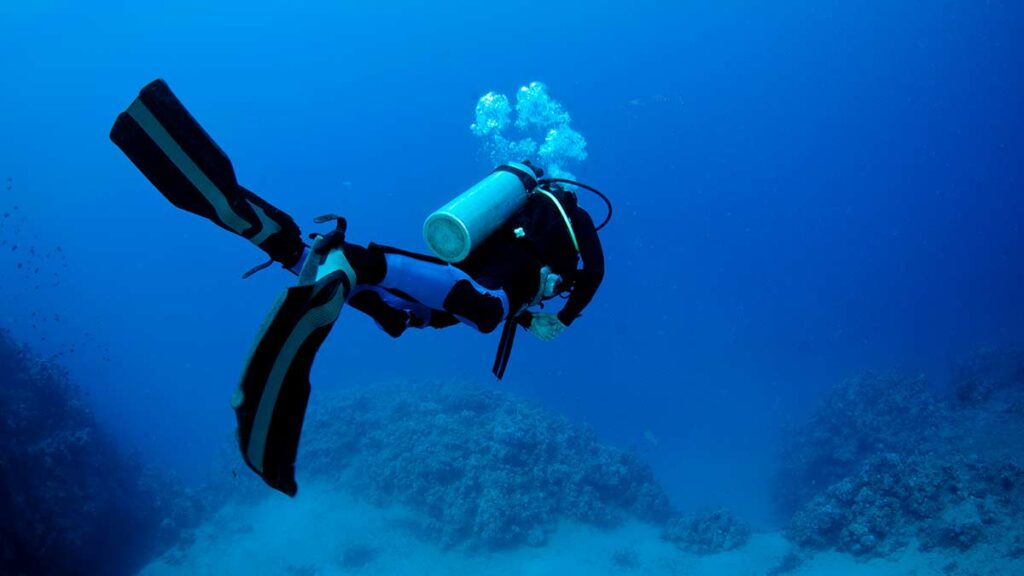
Valve Systems
The heart of a scuba tank — the valve — determines how you connect your regulator. The valve is attached to the neck of the scuba tank, and its primary purpose is to control the airflow from the cylinder to the first stage of the regulator. They are the connection point to your underwater lifeline!
Types of Valves – DIN and Yoke Valves
It needs to be connected to your regulator to ensure your tank functions properly. DIN (an acronym for Deutsche Industrie Norm) and Yoke are the two primary types of coupling fittings that link your tank to the regulator’s initial stage.
Yoke Valves
Predominantly seen in the US, Yoke connection fittings are widely favored. They are the standard fittings for aluminum 80 tanks, typically provided when renting diving tanks. Yoke valves are straightforward to link and remove but sit externally on the tank’s neck. While they are the preferred choice for many leisure divers, this external placement might make them less stable under extremely high pressures.
DIN Valves
Popular in Europe, DIN valves offer a more secure connection and are suitable for deeper dives. DIN valves sit recessed inside the tank. They provide a secure connection, so tech and deep divers have a soft spot for them. DIN coupling fittings are necessary for high-pressure tanks and are safer than Yoke varieties. With a DIN coupling fitting, the O-ring cannot stick out because the fitting screws right into the tank valve, keeping the O-ring in place.
Aluminum tanks commonly have yoke valves, while steel tanks (especially high-pressure steel tanks) are likely to have DIN valves. Divers should consider which tank style they will likely use when investing in a scuba regulator.
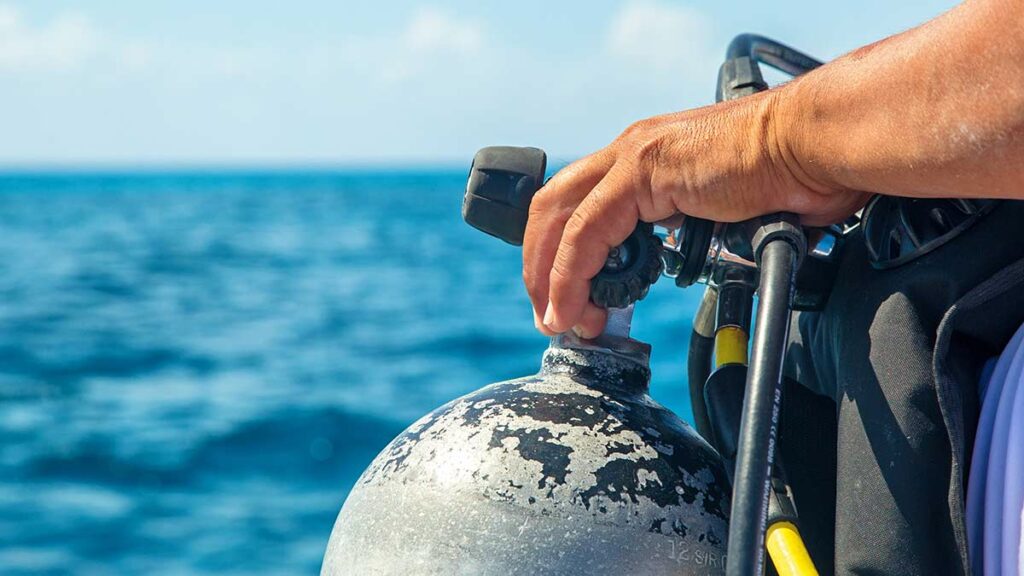
Filling Your Scuba Tank: It’s Not Just About Air
Three key elements influence the air available to a diver in a scuba tank: diving depth, personal air use, and dive depth.
Diving Depth
The deeper a diver descends, the faster they’ll consume air. While the compressed air in the tank remains unaffected by underwater pressures, the moment it travels from the tank to the diver’s breathing apparatus, it gets compressed further. This means during a specific time, say five minutes underwater, a diver will utilize more air than they would at the same time above water. Thus, with increased depth, the available air depletes faster.
Personal Air Use
Various factors, including height, weight, emotional state, and physical activity, dictate the amount of air a diver consumes per breath. For instance, a taller individual typically requires more oxygen per breath than someone shorter. Similarly, a diver who is anxious or stressed might breathe more rapidly, depleting the tank quicker than a calm and composed diver.
Tank Size
As discussed earlier, a tank’s size is crucial. Generally, a tank with a larger capacity provides air for a longer duration.
Many non-divers assume scuba tanks are filled with 100% oxygen. Scuba divers never use pure oxygen because oxygen becomes toxic as pressure increases beyond a certain point. In reality, recreational divers typically use filtered and compressed air (approximately 21% oxygen and 79% nitrogen).
Technical divers diving in deep waters use enriched air nitrox, which contains more oxygen (ranging from 22% to 40% oxygen, with the remainder filled in with nitrogen) and allows for longer bottom times. Ensure you’re certified to use nitrox and understand its benefits and limitations.
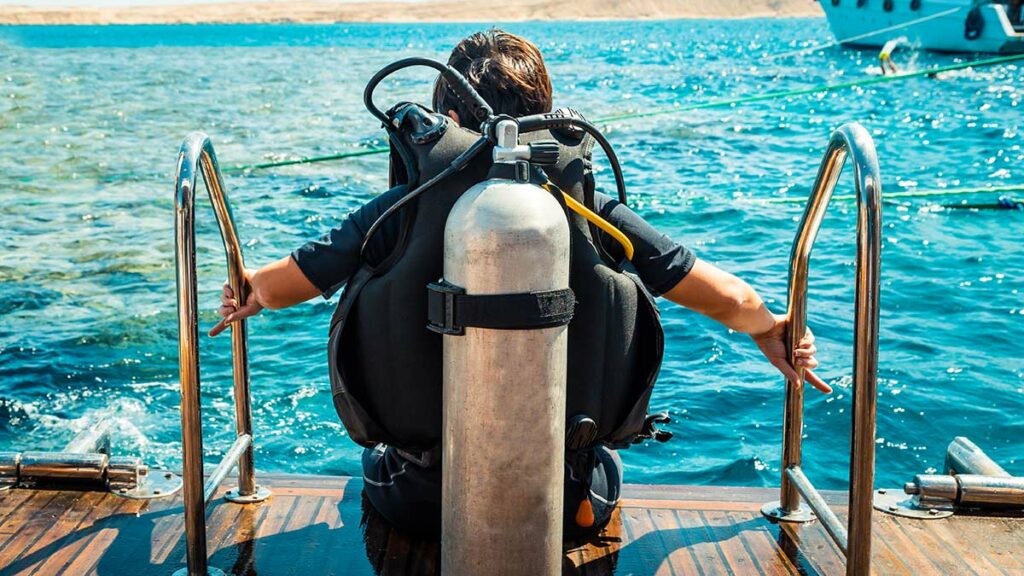
Maintenance and Care of Diving Tanks
To ensure longevity and safety, regular care of your tank is essential.
Regular Inspections
Inspecting your tank is like going for regular check-ups. It ensures you’re fit and ready to explore! Ensure your tank undergoes visual inspections annually by a qualified visual cylinder inspector and hydrostatic tests every five years. Hydrostatic testing is vital to maintaining the reliability of tanks and, therefore, imperative to keep your safety. Dive cylinders will have the last date of hydrostatic testing embedded into them.
Proper Storage
Saltwater and tanks? Not the best combo. Always give your tank a good rinse post-dive with fresh water, and store tanks in cool, dry places away from direct sunlight to increase your tank’s lifespan.
Consider your tank’s vintage wine; proper storage is the key to longevity.
Scuba Tank Buying Guide: What to Consider
Purchasing a scuba tank is an investment. Here’s what to keep in mind. Consider factors like material, weight, capacity, and your diving style. Whether you’re a casual holiday diver or a deep-sea explorer, a tank out there is perfect for your needs.
Your Dive Profile
Are you a recreational or professional diver? The answer will determine the type and features of the tank you need.
Budget and Brand Preference
With several brands offering tanks in various price ranges, research and reviews can determine what fits your pocket and needs.
The Environmental Impact
Our oceans are precious. While diving gives us a unique perspective, it’s vital to dive sustainably. And yes, your tank plays a part in this!
Be cautious about where you place your tank. Damaging fragile marine life or reefs is a big no-no. Being a responsible diver means ensuring the preservation of underwater ecosystems.
Don’t just discard; recycle! An old tank can find new life, perhaps even as your next dive bell.
Conclusion: Embracing the Deep Blue with Knowledge
Understanding your scuba diving tank is about maximizing your dive time, ensuring safety, and being responsible. The deeper your knowledge, the deeper you can dive, literally and figuratively. So, gear up, dive in, and let the mesmerizing underwater world take your breath away — just not all of it, thanks to your trusty tank!

